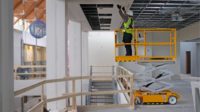Restoring the Splendor of the Great Stupas

Designed to last 1,000 years, the Great Stupa was built with the most advanced materials available to help it withstand the harsh climate at the elevated mountain site.

Restoring the dramatic gateways with a high-performance protective coating was overdue, as the paint on the intricately ornamented arches and support columns was significantly faded, chipping and flaking.

Painting the many different ornamental shapes was a very slow process due to the precision required and the team’s high standards of perfection.

Painting the many different ornamental shapes was a very slow process due to the precision required and the team’s high standards of perfection.

The splendor of the first completed gateway has been fully restored with a vibrant, colorful and ultradurable Kynar Aquatec®-based NeverFade® coating that will protect this architectural treasure for many years to come.





For centuries, religious sanctuaries and monuments have been designed and constructed according to the highest architectural standards. More than mere buildings, they are hallowed and inspirational symbols of the devotion and reflection within.
Nestled high atop the Rocky Mountains in Northern Colorado, the Great Stupa of Dharmakaya is one of the most magnificent examples of Tibetan sacred architecture outside of Asia. Consecrated in 2001, this unique, 108-foot-tall architectural treasure was designed according to strict Buddhist tradition and constructed using complex geometric calculations.
With many vibrant colors, the Great Stupa is one of the most beautiful structures in the Western hemisphere, and four exquisitely ornamented entry gates architecturally distinguish it from any other stupa in the world.
Extreme Weathering Environment
Designed to last 1,000 years, the Great Stupa was built with a specially designed concrete to help it endure the dramatic freeze-thaw cycles and harsh climate at the site’s 8,000-foot elevation. These extreme weather conditions—especially radical temperature swings and intense UV light—are also particularly tough on paint, prompting lower-quality, less-durable formulations to peel, flake, fade, and degrade more rapidly than a premium high-performance protective coating.
The team responsible for preserving the facade of the Great Stupa recently determined that the exterior coating applied 11 years ago—a good-quality acrylic latex paint—had reached the end of its service life, resulting in a dramatic weathering and dulling of the colorful gateways. “There was very noticeable fading of the beautiful archways, and the coating was chipping and flaking on the support columns,” says Bob King, project manager for the Great Stupa restoration team. “It was clearly time to restore the concrete gateways to their former glory as their overall appearance was very dull and significantly faded.”
Desired Long-lasting Protection
A primary goal of the Great Stupa restoration project was to find and apply a best-in-class architectural coating that would provide long-term durability, extreme weatherability, and outstanding resistance to dirt/dust pickup in the harsh high-altitude climate conditions. “It takes a very long time to perform the restoration work on the gateways, which makes coating longevity extremely important,” says King. “If we can recoat the structure half as often, we are saving an enormous amount of man-hours of labor.”
Vibrancy and color were also important considerations in the coating selection according to Joshua Mulder, director of art and design for the Great Stupa restoration team. “We wanted to make the gateways look as beautiful as we could and for the rejuvenated look to radiate brightness and richness for a very long time,” he says.
High-performance Coating Solution
After researching various high-quality architectural finishes, the maintenance team decided that an ultradurable product from APV Engineered Coatings, called NeverFade Façade Restoration Coatings, offered the optimal performance properties needed for protecting the building facade and preserving color vibrancy in the harsh climate.
“We were impressed with the coating system’s extreme weatherability and extended service life performance, which is backed up with a 15-year product and labor warranty against color fading from the manufacturer,” says Richard Assaly, lead painter for the Great Stupa project team. “It was the ideal solution to meet the challenging goals of the restoration work.”
Available in eggshell and semi-gloss sheens, plus custom-color matching, NeverFade Original Topcoat is engineered specifically for concrete, stucco, masonry, and other composite building materials. The product is based on Kynar Aquatec emulsions, which are used in high-performance architectural coatings for keeping building facades looking vibrant and appealing. Developed by Arkema Inc., this water-based PVDF fluoropolymer technology provides the same long-lasting durability, extreme weatherability, and color-retention properties as Kynar 500 resin-based coatings, which can withstand extended exposure to temperature extremes, ultraviolet rays, and other aggressive climate conditions.
Challenging Application Goes Smoothly
Based on color cards provided by the Great Stupa’s facade-restoration team, APV Engineered Coatings created 15 vibrant custom colors of the NeverFade coating for the project—four colors for the columns and eleven colors for the gateway’s ornamental design elements.
While NeverFade coatings typically are applied by manufacturer-approved or certified contractors, in this instance, the Great Stupa assembled a team of volunteers to handle the job. Prior to applying the topcoat, workers pressure-cleaned the concrete substrate and made sure no chalking was left on the surface. Over the course of a week in the summer of 2018, the painting crew reached a preliminary goal of restoring one gateway and about 25 percent of a second gateway. Project manager King explained that the painting was a very slow process due to the precision required and the team’s high standards of perfection. “We were applying the coating with very small brushes and there were a lot of cut-ins, multiple colors to work with, and many different ornamental shapes,” he says.
According to lead painter Assaly, the one-component coating was very user-friendly and easy to apply. “The product has wonderful flowability and workability,” he says. “The colors were so vibrant and rich that as each painter applied the coating, the luscious color just jumped out at them and they were astonished.”
Long-lasting Beauty Restored
With the makeover of one entry gate complete, the Great Stupa’s maintenance team will turn its attention to restoring the other three gateways to their former splendor with the high-performance NeverFade Original Topcoat product.
“We are strongly committed to maintaining this sacred, colorful monument to the utmost degree of perfection that we can, which is why we are so pleased to have used this high-quality coating system to keep it crisp, vibrant, and beautiful for many years ahead,” says Mulder. “When visitors see the newly restored gateway, they’ll find it very easy to appreciate the freshness and radiance of the new coating.”
Looking for a reprint of this article?
From high-res PDFs to custom plaques, order your copy today!










